Monthly Feature DECEMBER 2014

The holiday season is upon us!
Shopping, decorating, getting those handmade gifts and cards ready, cleaning for company, cooking and baking cause a flurry of activity. If you have young children, their excitement can be contagious, making the upcoming holiday even more fun for the whole family.
The stories of the holidays make great telling or reading, too. Some families read ‘Twas The Night Before Christmas’ every Christmas Eve, other families tell the story of Hanukkah each year, while still other families cherish the meaning of Kwanzaa or other winter holiday celebrations.
These celebrations are what help us connect to our history, our families and cultures.
Spending time with your herbs is a perfect way to slow down, catch your breath and become involved in age old traditions. Whether you’re cutting herbs for drying and making into bundles to decorate your packages or to give as culinary gifts or you’re making herb tea and cookies for a small gathering, just having the herbs around you, smelling them and handling them can help you relax, remember your summer garden and think about next year’s growing season.
I like to incorporate herbs in all I do for the holidays. I add herbs to sugar cookie and shortbread recipes, give gifts of herb vinegar, serve herb butter with holiday meals and of course use herbs in stuffings, soups and other main dishes. Decorating with herbs adds fragrance and history to your winter holiday. Herbs are a connection to our past. They have nothing to do with crowded malls, shopping, over used credit cards and canned holiday tunes coming out of loudspeakers.
No matter what your culture or traditions, food is a major part of any holiday tradition. And, herbs are a natural part of winter holiday cooking. Whether you add sage to your Christmas turkey dressing, mint or rosemary to a leg of lamb for Hanukkah or use thyme and savory in a soup, stew or gravy recipe, you are upholding ancient traditions. Herbs have been used, as we know, throughout the world to flavor, preserve and enhance food.
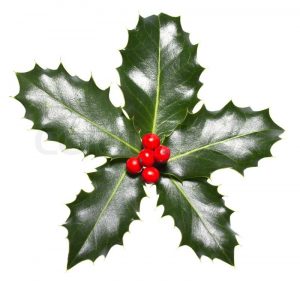
Herbs have a place in holiday traditions beyond the kitchen and dining table. Many of the common herbs we use today have traditions stemming from the time of Jesus and before.
Rosemary, Rosmarinus officinalis, has been used since about 500 B.C.E. (Before the Common Era) in Greece because of its ability to strengthen the brain and aid memory. So, it is no accident that we have Rosemary for Remembrance in the meanings of herbs. Rosemary was often tossed into a grave and given to the grieving family of the deceased to indicate the deceased would not be forgotten. It was also woven into wreaths for brides to wear at the wedding to remind the participants not to forsake their wedding vows. It is also used to represent friendship and fidelity. Some say it is the strong fragrance of Rosemary that causes it to be remembered so strongly.
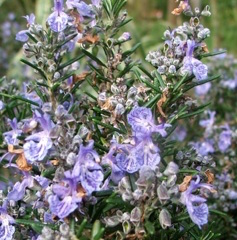
Rosemary, Rosmarinus officinalis, blooming right now at The Herb Cottage
Another legend relating to Rosemary claims that on midnight January 5, the Old Christmas Eve, Rosemary plants will burst into flower to celebrate Christmas. Rosemary is effective used with other holiday greens such as pine, holly and the like, for decorative wreaths and swags. Little sprigs made into tussie mussies with other herbs and decorated with ribbons, lace, etc. can be used at individual place settings for an herbal touch to a table setting.
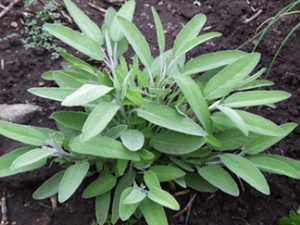
Sage, Salvia officinalis, at The Herb Cottage.
Some other herbs that are common in the holiday tradition for their meanings are Sage for immortality and domestic happiness, Lavender for purity and virtue, Horehound as a representative of giving good health, and Rue to banish evil and as a symbol of grace. Thyme represents bravery and was said to have been collected to use as a soft bed for Mary during the birth of her child. It is thought to have antiseptic properties and was burned as incense by the Greeks. It is a popular culinary seasoning today, and can also be used in bouquets both fresh and dried.
Costmary or Bible Leaf represents everlasting life. Leaves of the Costmary plant were used as book marks for bibles and hymnals in the American Colonial period. The story goes that worshippers would nibble on the Costmary leaf to keep themselves awake during long services and boring sermons!
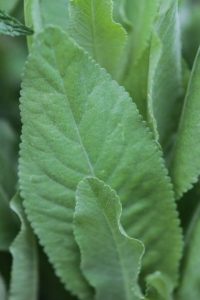
Costmary Leaves
Costmary, Tanacetum balsamita or Chrysanthemum balsamita, is related to Common Tansy and is an herb not much grown today. It is a native of Asia, but has become naturalized in many parts of Southern Europe. It was introduced to England in the 16th Century and used to be found in every English garden. It was used to flavor ale, due to its taste and aroma. Indeed, it was sometimes called Alecost. Fresh leaves were also used in salads and as a pot herb in soups and stews, similar to Pot Marigold or Calendula. Dried leaves were used as a strewing herb and to scent pot-pourri.
Costmary is a root hardy perennial to USDA Zone 4. It is easily divided in the Spring or Autumn. If grown in the shade it will produce many leaves but no flowers. If grown in the sun, it will flower profusely and can be invasive. Deadhead flowers and pull up runners to keep it in bounds. It has a flavor described as a mix of mint and balsam. Use it in lemonade or iced tea. Young leaves can be used in salads, cold soups or layered in a cake pan, similar to the use of Rose Scented Geranium leaves.
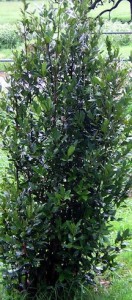
Bay Laurel, along with Costmary, was used in ancient European times as greenery decorations to help celebrate the Winter Solstice. Bay Laurel is associated with Apollo, God of Light, and serves as a reminder that the long winter season will eventually melt into spring when the earth seems to come alive again.
Bay Laurel, Laurus nobilis, at The Herb Cottage
So, as you celebrate the holidays with family and friends, know that if you incorporate herbs in your decorations, drink and food, you’ll be upholding ancient and modern traditions. Let’s raise a cup to Peace and Goodwill during this Holiday Season.
QUOTE FOR THE MONTH
“At Christmas play and make good cheer, for Christmas comes but once a year.”
Thomas Tusser quotes (English farmer and writer. 1524-1580)
